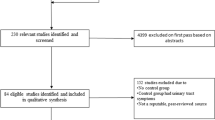Abstract
This study was carried out to determine whether five experts in female stress urinary incontinence (SUI) could discover a pattern of urethrovesical movement characteristic of SUI on dynamic perineal ultrasound. A secondary analysis of data from a case–control study was performed. Ultrasounds from 31 cases (daily SUI) and 42 controls (continent volunteers) of similar age and parity were analyzed. Perineal ultrasound was performed during a single cough. The five experts, blinded to continence status and urodynamics, classified each woman as stress continent or incontinent. Correct responses ranged from 45.7% to 65.8% (mean 57.4 ± 7.6). Sensitivity was 53.0 ± 8.8% and specificity 61.2 ± 12.4%. The positive predictive value was 48.8 ± 8.2% and negative predictive value was 65.0 ± 7.3%. Inter-rater reliability, evaluated by Cohen’s kappa statistic, averaged 0.47 [95% CI 0.40–0.50]. Experts could not identify a pattern of urethrovesical movement characteristic of SUI on ultrasound.

Similar content being viewed by others
Abbreviations
- SUI:
-
stress urinary incontinence
- MUCP:
-
maximum urethral closure pressure
References
Bai SW, Kwon JY, Chung DJ, Park JH, Kim SK (2006) Differences in urodynamic study, perineal sonography and treatment outcome according to urethrovesical junction hypermobility in stress urinary incontinence. J Obstet Gynaecol Res 32:206–211
Schaer GN, Perucchini D, Munz E, Peschers U, Koechli OR, Delancey JO (1999) Sonographic evaluation of the bladder neck in continent and stress-incontinent women. Obstet Gynecol 93:412–416
Reddy AP, DeLancey JO, Zwica LM, Ashton-Miller JA (2001) On-screen vector-based ultrasound assessment of vesical neck movement. Am J Obstet Gynecol 185:65–70
DeLancey JOL, Trowbridge ER, Miller JM, Morgan DM, Guire K, Fenner DE (2008) Stress urinary incontinence: relative importance of urethral closure pressure. J Urology 179:2286–2290
Hol M, van Bolhuis C, Vierhout ME (1995) Vaginal ultrasound studies of bladder neck mobility. Br J Obstet Gynaecol 102:47–53
Dalpiaz O, Curti P (2006) Role of perineal ultrasound in the evaluation of urinary stress incontinence and pelvic organ prolapse: a systematic review. Neurourol Urodyn 25:301–307
Chen GD, Su TH, Lin LY (1997) Applicability of perineal sonography in anatomical evaluation of bladder neck in women with and without genuine stress incontinence. J Clin Ultrasound 25:189–194
Sendag F, Vidinli H, Kazandi M, Itil IM, Askar N, Vidinli B et al (2003) Role of perineal sonography in the evaluation of patients with stress urinary incontinence. Aust N Z J Obstet Gynaecol 43:54–57
Benson JT, Sumners JE, Pittman JS (1991) Definition of normal female pelvic floor anatomy using ultrasonographic techniques. J Clin Ultrasound 19:275–282
Dietz HP, Clarke B, Herbison P (2002) Bladder neck mobility and urethral closure pressure as predictors of genuine stress incontinence. Int Urogynecol J Pelvic Floor Dysfunct 13:289–293
Minardi D, Piloni V, Amadi A, El Asmar Z, Milanese G, Muzzonigro G (2007) Correlation between urodynamics and perineal ultrasound in female patients with urinary incontinence. Neurourol Urodyn 26:176–184
Dietz HP, Clarke B (2001) Translabial color Doppler urodynamics. Int Urogynecol J Pelvic Floor Dysfunct 12:304–307
Martin JL, Williams KS, Sutton AJ, Abrams KR, Assassa RP (2006) Systematic review and meta-analysis of methods of diagnostic assessment for urinary incontinence. Neurourol Urodyn 25:674–684
Bai SW, Kang JY, Rha KH, Lee MS, Kim JY, Park KH (2002) Relationship of urodynamic parameters and obesity in women with stress urinary incontinence. J Reprod Med 47:559–563
Cassado J, Pessarrodona A, Tulleuda R, Cabero L, Valls M, Quintana S et al (2006) Introital ultrasonography: a comparison of women with stress incontinence due to urethral hypermobility and continent women. BJU Int 98:822–828
Borstad E, Rud T (1989) The risk of developing urinary stress-incontinence after vaginal repair in continent women. A clinical and urodynamic follow-up study. Acta Obstet Gynecol Scand 68:545–549
DeLancey JOL, Miller JM, Kearney R, Howard D, Reddy P, Umek W et al (2007) Vaginal birth and de novo stress incontinence; relative contributions of urethral dysfunction and mobility. Obstet Gynecol 110:354–362
Karram MM, Bhatia NN (1988) The Q-tip test: standardization of the technique and its interpretation in women with urinary incontinence. Obstet Gynecol 71:807–811
Bai SW, Woo JW, Shin JS, Park JH, Kim SK, Park KH (2004) The predictive values of various parameters in the diagnosis of stress urinary incontinence. Yonsei Med J 45:287–292
Oliveira FR, Ramos JG, Martins-Costa S (2006) Translabial ultrasonography in the assessment of urethral diameter and intrinsic urethral sphincter deficiency. J Ultrasound Med 25:1153–1158
Tunn R, Goldammer K, Gauruder-Burmester A, Wildt B, Beyersdorff D (2005) Pathogenesis of urethral funneling in women with stress urinary incontinence assessed by introital ultrasound. Ultrasound Obstet Gynecol 26:287–292
Funding
We acknowledge research support from the Office for Research on Women’s Health SCOR on Sex and Gender Factors Affecting Women’s Health and the National Institute of Child Health and Human Development 1 P50 HD044406.
Conflicts of interest
None.
Author information
Authors and Affiliations
Corresponding author
Rights and permissions
About this article
Cite this article
Lewicky-Gaupp, C., Blaivas, J., Clark, A. et al. “The cough game”: are there characteristic urethrovesical movement patterns associated with stress incontinence?. Int Urogynecol J 20, 171–175 (2009). https://doi.org/10.1007/s00192-008-0738-0
Received:
Accepted:
Published:
Issue Date:
DOI: https://doi.org/10.1007/s00192-008-0738-0




